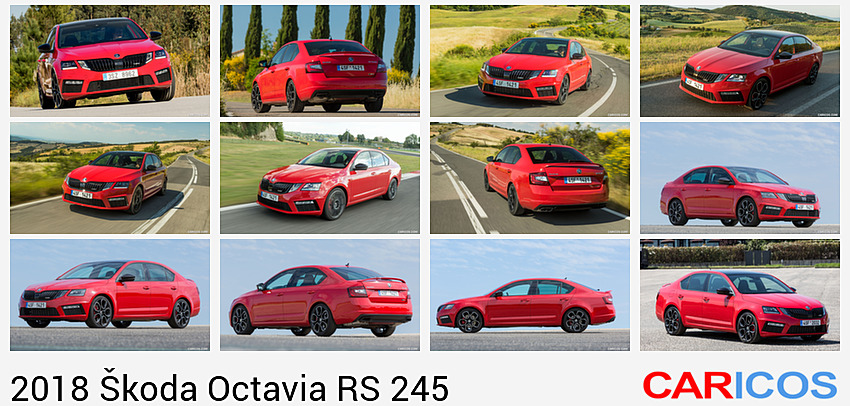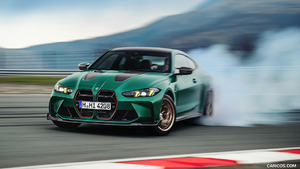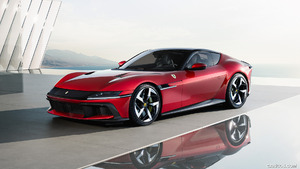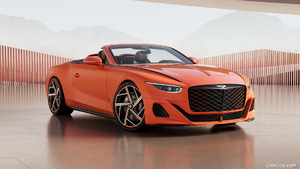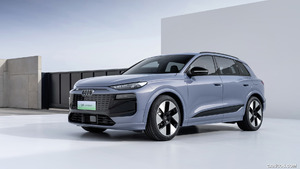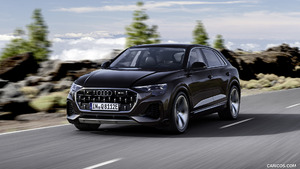2018 Octavia RS 245
"Check automaker Skoda released updated version of its sportiest Octavia, the RS 245. Both sedan and combi body types get 2.0-liter turbocharged engine that now produces 245 horsepower. Octavia RS 245 reaches 100 km/h from zero in 6.6 seconds and is capable of traveling at speed of up to 250 km/h. It has a new 7-speed transmission and lots of technological additions, such as infotainment system and VAQ limited-slip differential. For more info check out the press release below:" Ed.
It is the most powerful and most dynamic ŠKODA OCTAVIA in the company’s history – the new ŠKODA OCTAVIA RS 245. The bestselling range’s sporty top model delivers 180 kW (245 PS) – 11 kW (15 PS) more than the previous most powerful RS variant, the ŠKODA OCTAVIA RS 230. The powerful engine and innovative chassis technology, including an electronically regulated VAQ limited-slip differential, offer the ultimate driving experience. The sportster is available as a hatchback or a Combi. The compact sports car accelerates from 0 to 100 km/h in just 6.6 seconds (Combi: 6.7 seconds); its top speed is limited to 250 km/h. As is usual for a ŠKODA, the car features a spacious interior and boot. In addition, the latest driver assistance systems are also available for the ŠKODA OCTAVIA RS 245. Using the infotainment system, the occupants can be ‘always online’ thanks to the Wi-Fi hotspot and LTE module. Numerous ‘Simply Clever’ features demonstrate the practical talents of this powerful compact car. The overall package is unique in the compact sports car segment.
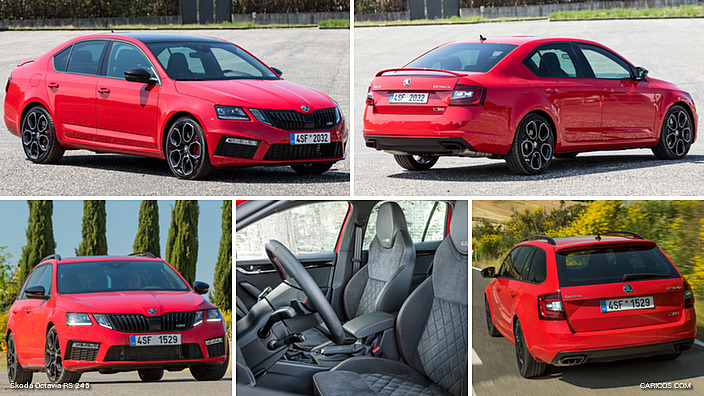 2018 Škoda Octavia RS 245
2018 Škoda Octavia RS 245
Design
The ŠKODA OCTAVIA RS 245 features the new face of the brand with particularly sporty details. The radiator grille’s vertical slats as well as its frame both come in a gloss-black finish. The bumper is designed with a particularly bold horizontal line, has broad honeycomb air inlets and contributes to the car’s wide and sculptured impression. The redesigned headlight clusters in a crystalline look feature full-LED technology and the AFS adaptive front light system as standard. The fog lights, tail lights and number plate illumination also feature LED technology as well as a crystalline appearance.
The housings of the electrically adjustable wing mirrors, featuring a memory function and puddle lights – which illuminate the surrounding area when getting in and out of the car – are presented in a sporty black finish. The radiator grille and the tailgate both sport the RS logo featuring a gloss-black ‘V’ (for victory). Features such as the spoiler at the rear of the hatchback or roof spoiler on the Combi are further elements of the car’s emotive and dynamic design. The ŠKODA OCTAVIA RS 245 can also be recognised as a high-performance sportster acoustically thanks to the throaty sound of its exhaust system. In keeping with the rest of the exterior, the trapezoid tailpipe trims are painted in gloss black.
With the ŠKODA OCTAVIA COMBI RS 245, the roofline gently slopes towards the rear and elegantly merges with the D-pillar. The finishing touches are provided by a spoiler lip (for the hatchback) and a roof spoiler (for the Combi). The rear light clusters create the impression of being embedded while LEDs fulfil almost all of the lighting functions. The brand-typical C-shaped tail lights have the appearance of homogeneous lighting surfaces. Contours incorporated into the lights ensure better aerodynamics, leading to a drag coefficient of 0.303 for the hatchback and 0.319 for the Combi.
Both the hatchback and the Combi are 4,689 mm long. The vehicles are 1,814 mm wide, and the hatchback’s height is 1.448 Milimeter, the Combi’s height is 1.452 Milimeter.At 2,680 mm, the wheelbase is unusually long for this vehicle segment. From these outer dimensions, ŠKODA engineers have created an interior that far exceeds the dimensions usually found in this segment and thereby provided a large amount of space.
These generous dimensions make the RS 245 models genuine family sportsters. The width of the loading floor – 1,010 mm in both the hatchback and the Combi – makes it easier to transport especially bulky items. The hatchback’s boot is also particularly generously sized: 590 l (1,580 l with the rear seats folded down). In the Combi, it is as high as 610 l (1,740 l with the rear seats folded down). Figures which even vehicles from higher segments only rarely reach.
The ŠKODA OCTAVIA RS 245 and ŠKODA OCTAVIA COMBI RS 245 are available in a choice of four body colours: Corrida Red, Moon White, Magic Black and Steel Grey.
Interior with Alcantara® sport seats
The predominantly black interior of the ŠKODA OCTAVIA RS 245 and ŠKODA OCTAVIA COMBI RS 245 impresses not only with its generous dimensions and great clarity, but also with its high-quality materials. With their high sides and integrated headrests, the Alcantara® sports seats provide maximum support in fast corners. The front seats bear the RS logo – as do the front door sills. The driver’s seat features red or grey topstitching, is electrically adjustable, offers lumbar support and has a memory function which saves three seat positions.
The multifunction sports steering wheel with perforated leather and integrated steering wheel paddles (for DSG transmissions) matches the car’s dynamic ambience. The radio and telephone (Bluetooth) can be operated from the optionally heated steering wheel. A colour Maxi-DOT display forms part of the instrument cluster. The LED ambient lighting bathes the interior in atmospheric light that can be set to one of ten various colours.
Drive and chassis – a lot of power, low consumption
Under the bonnet of the ŠKODA OCTAVIA family’s sporty top model beats a 180 kW (245 PS) four cylinder TSI petrol engine. It offers 11 kW (15 PS) more than the most powerful variant of the current RS model. Maximum torque of 370 Nm is achieved between 1,600 and 4,300 rpm. There is a choice of a 6-speed manual gearbox or – for the first time in a ŠKODA OCTAVIA – a 7-speed, dual-clutch transmission. From a standing start, the hatchback hits the 100 km/h mark in 6.6 seconds, the Combi takes 6.7 seconds. The top speed is electronically limited to 250 km/h, making the ŠKODA OCTAVIA RS 245 the fastest and most powerful OCTAVIA ever.
Yet the average fuel consumption when combined with a 7-speed DSG transmission is just 6.4 l per 100 km (6.6 l with a 6-speed manual gearbox), with CO2 emissions of 146 and 150 g/km respectively.
The acceleration is particularly impressive. In fifth gear, the ŠKODA OCTAVIA RS 245 with a manual gearbox sprints from 60 to 100 km/h in just 6.4 seconds (Combi: 6.5 seconds) and from 80 to 120 km/h in only 6.6 seconds (Combi: 6.8 seconds) – a reassuring safety cushion.
Compared to the ‘normal’ models in the range, the sports chassis lowers the body of the ŠKODA OCTAVIA RS 245 by 15 mm. Its rear track is 30 mm wider than that of the ŠKODA OCTAVIA RS 230 predecessor. The standard, burnished gloss-black alloy wheels are 19 inches in diameter.
The ESC stability system with Sport mode is also part of the standard equipment, as is the driven wheels’ electronically regulated VAQ limited-slip differential. This provides for particularly dynamic acceleration when exiting corners. The technology, that was originally developed for motorsport, works with an electronically regulated multi-plate clutch that is located between the differential and the powered axle on the right-hand side. As and when it is needed, 100 per cent of the power can be directed to one front wheel. When cornering, the differential transfers an increased amount of engine power to the outer front wheel – i.e. to the wheel with the most grip – as required. The risk of understeering during acceleration is significantly reduced.
Performance Mode Select with the Performance Sound Generator function enables individual adjustment of drive, chassis and comfort settings. The dynamic character of the ŠKODA OCTAVIA RS 245 is additionally highlighted by the car’s progressive steering and the optional adaptive Dynamic Chassis Control (DCC).
Electrically operated valves adjust the dampers’ settings. The driver has access to three modes to do this: Comfort, Standard and Sport. In addition, DCC contributes to increased active safety by automatically switching to Sport mode when cornering in a particularly dynamic manner and, in doing so, ensures greater stability, better traction and shorter braking distances.
With Driving Mode Select, the driver can change the steering characteristics, the operation of the DSG transmission, and the settings of other systems in the Normal, Eco, Sport and Individual modes. The individual preferences are saved on the optionally available, personalisable keys. These also store further individual settings such as those for the Climatronic and audio systems as well as seat position, and apply them automatically.
Driver assistance systems that are otherwise only seen in higher segments
Front Assist including the City Emergency Brake function with Predictive Pedestrian Protection helps to prevent accidents in city traffic. With the help of a radar sensor, the system can recognise critical situations occurring in front of the vehicle.
In addition, the car comes with the following safety system as standard or as optional extras:
Blind Spot Detect. With this, two radar sensors at the rear monitor traffic behind the vehicle.
Blind Spot Detect also includes Rear Traffic Alert. Using the same rear radar sensors, this system makes reversing out of bay parking spaces and drives safer.
The radar-based Adaptive Cruise Control (ACC) maintains the desired gap from the vehicle in front at a preset speed by automatically braking or accelerating. The radar sensor in the radiator grille works at speeds between 30 and 210 km/h.
Lane Assist helps the driver to stay in lane by warning the driver via the multifunction display or gently adjusting the steering where necessary. The system assists the driver at speeds above 65 km/h.
The Driver Alert fatigue detection system recognises when the driver’s concentration is waning. For this purpose, the system transfers information about steering wheel movements to the control unit. If necessary, the system prompts the driver to take a break.
If an accident is imminent, the proactive occupant protection system Crew Protect Assist is activated: this system closes the windows and sunroof (leaving a small gap) to prevent passengers from being thrown out of an open window, prevents foreign bodies from getting into the interior of the vehicle, and tensions the seat belts for the driver and front passenger. Crew Protect Assist works in conjunction with Front Assist. In the event of an accident, the Multi-Collision Brake, which comes as standard, prevents the car from rolling any further in an uncontrolled manner. In addition, the hazard and brake lights are activated.
The camera-based Travel Assist with Traffic Sign Recognition displays speed limits and other road signs as images on the in-car computer as well as on the navigation system’s screen.
Manoeuvre Assist, which is also new, helps when driving in and out of parking spaces: it applies the vehicle’s brakes as soon as it detects an obstacle.
Park Assist 3.0 automatically steers the vehicle into parallel parking spaces and spaces perpendicular to the road. The system can be activated at speeds of up to 40 km/h for the recognition of parallel parking spaces and at up to 20 km/h for bay parking spaces.
The optional Trailer Assist function prevents incidents when reversing with a trailer.
Hill-Hold Control helps the driver when performing a hill start. The system is activated on inclines of five per cent and above and allows for relaxed and safe hill starts without using the handbrake.
High Beam Assist rounds off the programme. In darkness and when the speed exceeds 60 km/h, the sensor recognises vehicles ahead (at a distance of up to 400 m) as well as oncoming traffic (up to 1,000 m) and dips the beam when required.
The comprehensive package of restraint features remains unchanged in the revised model range. Five three-point seat belts working in complete harmony with up to nine airbags ensure maximum safety on board. Child seats can be secured using Isofix (as an option, also available for the front passenger seat) and top tether anchor points. Tyre pressure monitoring remains a standard feature in all model variants.
In the Euro NCAP crash test, the ŠKODA OCTAVIA achieved in 2013 the top mark of five stars for occupant safety, top values of 93 per cent for adult protection and 86 per cent with children on board.
Infotainment systems ensure protection and entertainment
Safety and entertainment is provided by the new infotainment systems. Four hardware components are available: the Swing (standard) and Bolero music systems as well as the Amundsen and Columbus navigation infotainment systems. In the ŠKODA OCTAVIA RS 245, they display a digital start screen. The capacitive touch displays react to the lightest of touches. The displays of the optional Bolero, Amundsen and Columbus infotainment systems with their new glass design refine the high-quality dashboard even further.
The Columbus navigation system is at the top of the range. Its 9.2-inch screen provides a resolution of 1,280 × 640 pixels. There is also a 64-GB flash memory, a DVD drive and an optional LTE module, which supplies the occupants with high-speed Internet (download at up to 150 Mbit per second).
The occupants can be ‘always online’. The Infotainment Online services are provided free of charge for the first year for the Amundsen and Columbus navigation infotainment systems. In the Amundsen system, they work via the user’s smartphone, which is paired with the system, or a data stick. In the Columbus system, they work via the user’s smartphone or an inserted customer SIM card with high-speed LTE.
ŠKODA Connect – mobile online services set benchmarks
The mobile online services from ŠKODA Connect ideally complement the infotainment offering. They take navigation, information, entertainment and assistance to a new level and are divided into two categories:
- The newly available Infotainment Online services for information and entertainment.
- Care Connect services for driver assistance and remote vehicle access.
One of the highlights of the Infotainment Online services is Online Traffic Information, which transfers traffic flow on the selected route to the car in real time and suggests alternative routes in the event of a traffic jam. The petrol station service lists petrol stations (including fuel prices) along a selected route. The Parking Spaces, News, and Weather services provide further tailored information.
The automatic Emergency Call is optional : if a restraint system has been activated following an accident, the system establishes a voice and data connection to a dedicated emergency call centre.
There is also an info function and a Breakdown Call. The ‘i’ button in the roof module enables the driver to contact an expert in the customer call centre, in order to have technical questions answered, for example. In the event of a breakdown, help can be organised using the breakdown button.
When a customer activates the Proactive Service feature, their dealership contacts them when a service is due to arrange a convenient appointment. In addition, service-relevant vehicle data can be transferred to the ŠKODA garage.
Additional online services can be accessed on a smartphone using the ŠKODA Connect app. Have the lights been switched off, are the doors locked, the windows and sunroof closed? The driver can view this information remotely, at any time. The same applies to the fuel level and the resulting vehicle range. It is also possible to display the vehicle’s current parking location on a smartphone. Don’t want the car to leave a predefined area or exceed 130 km/h? The Area Notification, Online Anti-Theft Alarm and Speed Notification functions inform the owner if this occurs against their wishes.
The Care Connect services are available free of charge in the first year after the purchase of a ŠKODA OCTAVIA RS 245 or ŠKODA OCTAVIA COMBI RS 245. The Remote Access services then incur a charge whilst all other Care Connect services remain free for another 13 years. The data is transferred via a SIM card that is installed in the vehicle.
A wealth of ‘Simply Clever’ features
ŠKODA is known for its many practical solutions. The ŠKODA OCTAVIA RS 245 and ŠKODA OCTAVIA COMBI RS 245 come with several useful features.
Here is just a selection of them:
- Bottle holder in the centre console makes it possible to open PET bottles with one hand.
- Heated steering wheel
- Two USB ports in the rear
- The Phonebox in the centre console charges a smartphone inductively
Further ‘Simply Clever’ features specially for the Combi models:
- Removable LED torch in the boot
- Adjustable false boot floor
- Multifunctional shelf under the boot cover
- Boot barrier net – this can also be used when the rear seats are folded down thanks to the adjustable fixing points
- Four bag hooks in the boot
- Two boot lights
- 12-volt socket in the boot

